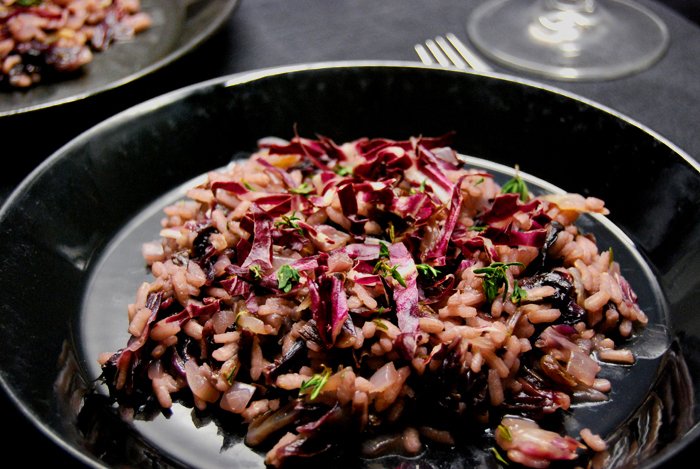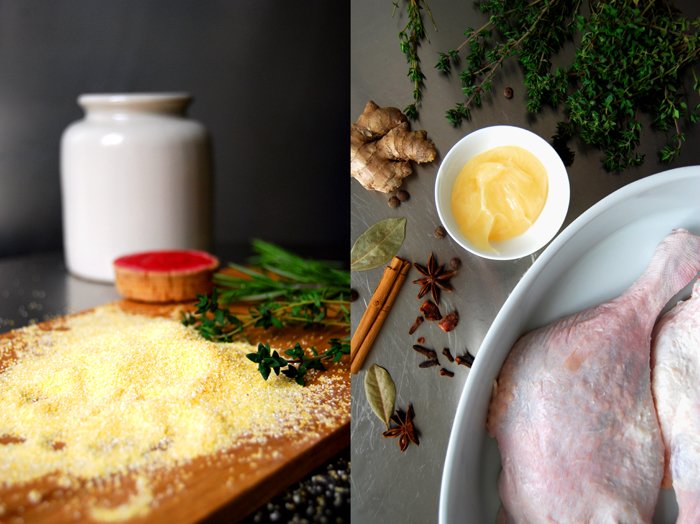Roast Quail with Spice Crust
I remember when I was a child I refused to eat quail, I didn't like the idea of cooking a bird of that size. I got older, learnt that there is no difference between eating chicken, quail or any other fully grown bird and then one day, I tried a piece of its juicy meat. I was convinced within seconds! I have since tried out many recipes, fruity with roast grapes, quail with different herb variations, pure and buttery, exotic quail with various spice mixtures, so many possibilities that change with the seasons. There's one thing these recipes have in common, I always fry the quail in fat with a piece of garlic and then I roast it in the oven for 8-10 minutes. It makes the skin crisp and the meat doesn't loose its juices.
You can play around with quite a few aromas because it tastes so strong, it allows you to be more experimental than with chicken. I love to look through my big box of spices and follow my nose to choose the right mixture. It makes me feel like a child in a sweet shop! This time I go for 1 small star-anis, 2 cloves, 12 black pepper corns, 1 teaspoon of coriander seeds and 1/4 teaspoon of aniseed, everything ground coarsely in my mortar. This spice mixture makes the crust for 2 quails. I had some goose fat in the fridge, perfect for frying poultry but you can use butter instead. I fried the birds together with 1 clove of garlic cut in half until their skin was golden brown on all sides and put them into a baking dish. The buttery juices mixed with a dash of lemon juice go over the quails, followed by the spices rubbed into their skin and some salt. Now they just need to go into the oven, set to 200°C / 390°F, I used the Rotitherm roasting setting which works perfectly for poultry. Mine were done in 8 minutes, I had bigger quails which needed up to 15 minutes depending on their size.
We focused on the quail and enjoyed this meal with slices of white bread to dip into the spiced juices and a salad on the side.
A Purple Risotto with Bitter Radicchio
When it comes to risotto I like the rice to have a bit of bite, with a velvety texture and not too liquid. I always make mine with broth and wine adding a little at a time so that I don't miss the point of my favoured texture. What's great about this meal is that it's made of ingredients which I usually have in stock. There are always one or two vegetables in my fridge waiting to be used and Arborio rice, onions, garlic, olive oil and wine to cook is on my shelves anyway. So it's perfect for an indecisive day when I don't know what to put on my cooker, or I don't have the time to think about dinner. Conveniently, it's also ready in half an hour!
My purple risotto has a biting bitterness from the radicchio which combines very well with the thyme. The rice is infused with the strong flavours in my broth and spices. I use a bay leaf and cloves which introduce a woody element to the bitterness (although that sounds strange, it describes it best!). When I cook with radicchio I like to have a strong counterpart to balance out its dominant character.
Radicchio Risotto with Spices and Thyme
For 2 hungry people you need
Arborio rice 200g / 7 ounces
radicchio, quartered and cut into slices, 1 medium sized head (I cut a few radicchio slices very thinly which I leave uncooked for the topping)
onion, chopped finely, 1
garlic, cut in half, 1 clove
red wine around 200ml
broth 1200-1500ml
fresh thyme leaves from 4-6 sprigs
bay leaf 1
cloves 2
salt and black pepper
olive oil for frying
butter 1 tablespoon
In a large pot, fry the onions and garlic in a little olive oil until golden and soft, stir in the rice and radicchio and fry on medium temperature for a couple minutes. Deglaze with 1/3 of the wine, let it cook until evaporated and repeat twice, stirring in between. Add 4 sprigs of the thyme, the spices, salt and pepper and some of the stock, enough to cover the rice. The temperature should be between low and medium. When the liquid has been absorbed continue to add more broth, a little at a time stirring in between. Depending on the rice, it sometimes needs more or less liquids. When the rice is al dente and the broth is more or less absorbed take it off the heat, take out the spices, stir in the butter and season with salt and pepper to taste. Arrange on plates sprinkled with the uncooked radicchio slices and some thyme leaves.
Ginger Honey Glazed Duck with Spices and Polenta
Sometimes I don't have the time or patience to slow cook a whole duck for hours like I do with my Christmas Duck. Although this really makes for the most tender and juicy meat, I need a quicker alternative. Here's what I came up with, honey glazed duck legs, juicy as well, with crisp skin, rubbed with spices and - most importantly - you can enjoy all of this after about an hour. If I find the time I marinade the meat in the morning so that the flavours can spread and soak into the skin during the day but it's great either way.
I prefer the darker, deeper meat of wildfowl like duck, goose and pheasant, especially in the cold season. They allow you to rub strong spices and herbs into their skin without loosing their own qualities. For my duck legs, I went for an aromatic mixture of clove, bay leaf, ginger, star-anis, thyme, allspice and a good amount of honey for a crispy caramelized skin. The juices made an amazing sauce, a concentrate of all the spices, I just added some red wine. Perfect to dip the polenta in which I seasoned with thyme and rosemary.
GingerHoney Glazed Duck with Spices and Polenta with Thyme and Rosemary
I prepare the polenta around 4o minutes after I put the duck legs into the oven.
For 2 people you need
duck legs 2
red wine 250ml (or 100ml red wine and 150ml broth)
salt and black pepper
olive oil
For the marinade
aromatic honey 2 tablespoons
ginger, thumbnail sized, grated
thyme, leaves of 5 sprigs
allspice berries, ground, 3
cloves, ground, 5
bay leaf, ground, 1
star-anis, ground, 1
cinnamon, ground, 1/4 teaspoon
Warm up the honey in a small sauce pan until it becomes liquid, spread on the duck legs together with the spices and rub everything into their skin marinating them for 1 hour (if possible). You can also prepare them in the morning (like I do) and keep them in the fridge all day before you cook them in the evening.
For the duck legs
Set the oven to 260°C / 500°F. My oven has a Rotitherm roasting setting which works perfectly for poultry.
Put the duck legs into an oiled baking dish, skin side up, and season with salt and pepper. Pour the remaining honey and spices of the marinade over the duck and place the dish in the hot oven. When the skin starts to get brown after a few minutes turn the temperature down to 130°C / 265°F and pour the red wine into the baking dish (a little over the duck as well) and bake for 60 minutes. Check with a skewer, if only clear juices come out the duck is done. Keep the duck legs in a warm place, pour the juices into a sauce pan and season with salt and pepper to taste. I didn't even need to cook the sauce down. It was perfect, very intense, it didn't need anything else. If you like you can add some more honey, Balsamico or a little orange juice.
For the polenta
polenta 120g / 4 ounces
water 250ml plus 150ml for cooking
milk 250ml
thyme, leaves of 4 sprigs
rosemary, chopped, 1/2 - 1 teaspoon
salt 1 teaspoon
olive oil 2 tablespoons
In a sauce pan, mix 250ml of water with the milk and salt and bring to the boil. Take the pan off the heat, add the olive oil, polenta and herbs and mix with a whisk. Turn down the heat to the lowest temperature and put the pan back on. Cook the polenta for 10 minutes mixing and adding the rest of the water once in a while.
Salmon with a Crust of Winter Spices
Salmon is great to combine with strong flavours. Its own taste is so strong and unique but blends in perfectly with all kinds of herbs and spices, even exotic curry mixtures. When I saw this nice salmon steak at the fish counter I had to buy it. I didn't even plan to cook fish but it looked too good to pass by.
At the moment, I use a lot of juniper, bay leaves and cloves, the typical winter spices. I decided to give them a try on the salmon as well - as a rough crust. They are very strong and aromatic spices, a bit sweet and smoky. It was more an experiment of sorts but I was really impressed by the result. We ate it with fresh bread and a salad on the side. Enjoy a glass of white wine with your meal and you will have a small dose of summer in January!
Salmon with a Crust of Bay Leaf, Juniper and Clove
For 2 people you need
salmon steak, around 2cm / 3/4" thick, 1 big or 2 smaller steaks
olive oil
juice of 1/2 a lemon
For the crust
garlic, crushed, 1 clove
bay leaves, ground in a mortar, 2
juniper berries, ground in a mortar, 2
cloves, ground in a mortar, 2
black pepper, ground in a mortar, 6
Set your oven to 200°C / 390°F.
Grind all the ingredients for the crust in a mortar until you have a combined paste. Heat some oil in a non-stick pan (highest temperature). Rinse and dry the fish, season with salt and pepper and fry for 1 minute (on each side). Take the fish off the heat and spread the paste on the top side of the steak. Pour a bit of oil in a baking dish, mix with the lemon juice and place your salmon steak on top. Bake in the oven for 8 minutes, when you can lift the fish from the bones it’s done.












